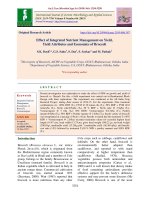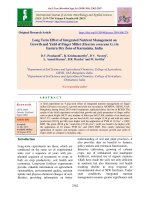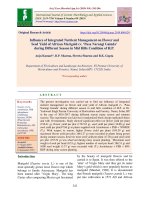Response of integrated nutrient management on soil properties, growth and yield of cluster bean (Cyamopsis tetragonoloba L.) Cv. Pusa sadabahar
Bạn đang xem bản rút gọn của tài liệu. Xem và tải ngay bản đầy đủ của tài liệu tại đây (280.41 KB, 8 trang )
Int.J.Curr.Microbiol.App.Sci (2017) 6(5): 2684-2691
International Journal of Current Microbiology and Applied Sciences
ISSN: 2319-7706 Volume 6 Number 5 (2017) pp. 2684-2691
Journal homepage:
Original Research Article
/>
Response of Integrated Nutrient Management on Soil Properties, Growth and
Yield of Cluster Bean (Cyamopsis tetragonoloba L.) Cv. Pusa Sadabahar
Asha*, Narendra Swaroop and Tarence Thomas
Department of Soil Science and Agricultural Chemistry, Sam Higginbottom University of
Agriculture, Technology and Sciences, Allahabad, 211 007 U. P., India
*Corresponding author
ABSTRACT
Keywords
Soil nutrients,
yield attributes,
FYM,
rhizobium,
NPK and
Cluster bean
Article Info
Accepted:
25 April 2017
Available Online:
10 May 2017
An experiment was conducted during Kharif (july-october) season 2016-17 to study
“Response of Integrated Nutrient Management on Soil Properties, Growth and Yield of
Cluster bean (Cyamopsis tetragonoloba L.) Cv. Pusa Sadabahar” on central research farm
of Sam Higginbottom University of Agriculture, Technology and Sciences Allahabad. The
soil of experimental area falls in order Inceptisol and soil texture was sandy loam (sand %
62.25, silt % 24.52 and clay % 13.23). The design applied for statistical analysis was
carried out with 3×2×2 factorial randomized block design having three factors with three
levels of NPK @ 0, 50, and 100 % ha-1, two levels of FYM @ 0 and 100% ha-1and two
level of rhizobium @ 0 and 100% respectively. The best treatment was T11 – [L2 F1 Z1]
(@ 100% NPK ha-1 + 100% FYM ha-1 + 100% rhizobium) showed the significant increase
on enrichment of soil fertility status. NPK, FYM and rhizobium in combination resulted in
a slight decrease in pH 6.89, EC 0.225 dS m-1. In post soil of NPK,FYM and rhizobium
fertilizers observations were resulted in significant increase in organic carbon 0.88 %,
particle density 2.66 Mg m-3, bulk density 1.05 Mg m-3 and available N 334.12 kg ha-1,
available P 34.76 kg ha-1, available K 214.74 kg ha-1. Significant increase in case of
nitrogen, phosphorus, potassium in treatment combination T11 –[L2F1 Z1] (@ 100% NPK
ha-1 + @ 100% FYM ha-1 + @ 100% rhizobium). The maximum cost benefit ratio was
recorded 1:2.85 in treatment combination [T11 – L2 F1 Z1] (@ 100% NPK ha-1 + 0%
FYM ha-1 + 100% rhizobium) and maximum net return (100438 ha-1) and highest pod
yield (77.22 q ha-1) in treatment combination [T11 – L2 F1 Z1] (@ 100% NPK ha-1 +
100% FYM ha-1 + 100% rhizobium).
Introduction
Cluster bean [Cyamopsis tetragonoloba (L.)
Taub] popularly known as “Guar” is an
important legume crop mainly grown under
rainfed condition in arid and semi-regions of
Rajasthan during kharif season. It is very
hardy and drought tolerant crop. Its deep
penetrating roots enable the plant to utilize
available moisture more efficiently and thus
offer better scope for rainfed cropping. The
crop also survives even at moderate salinity
and alkalinity conditions. There is no other
legume crop so hardy and drought tolerant as
cluster bean (Kherawat et al., 2013).
In India, cluster bean is mostly grown in
Rajasthan, Haryana, Punjab, Uttar Pradesh
and Madhya Pradesh. Rajasthan occupies first
position in India both in area and production.
2684
Int.J.Curr.Microbiol.App.Sci (2017) 6(5): 2684-2691
It accounts for almost 82.1% area and 70%
production in India. Haryana and Gujarat has
second and third position respectively.
Rajasthan has an area of 30 lakh ha,
production of 15.46 lakh tonnes with a
productivity of 515 kg ha-1. (Anonymous
2010-11). Rajasthan guar is mainly grown in
Barmer, Churu, Sriganganagar, Nagaur,
Jalore, Sikar, Jaisalmer, Bikaner, Jaipur,
Jhunjhunu and Alwar districts.
respiration of plants. It stimulates early root
development and growth and there by helps to
establish seedlings quickly. It enhances the
activity of rhizobium and increased the
formation of root nodules. Thus, it helps in
fixing more of atmosphere nitrogen in root
nodules.Hand book of Agriculture by ICAR,
(2010).
Nitrogen
The potassium is the 3rd most important
essential nutrient after nitrogen and
phosphorus. The potassium activates more
than 60 enzymes and enzymatically catalyzes
the system involved in photosynthesis,
metabolism
and
translocation
of
carbohydrates and proteins, membrane
permeability, stomatal regulation and water
utilization. Other benefits ascribed to K
include resistance of plants against pests,
disease and stresses caused by drought, frost,
salinity, sodicity and in assuring improved
crop quality characteristics (Kherawat et al.,
2013).
Nitrogen plays an important role in synthesis
of chlorophyll and amino acid, which
contributes to the building units of protein and
thus the growth of plants. Insufficient
nitrogen may reduce yield drastically and
deteriorates the quality of produce. Cluster
bean being a legume crop which has the
capacity to fix atmospheric nitrogen by its
effective root nodules the major part of
nitrogen is met through rhizobium present in
the root nodules hence, crop does not require
additional nitrogen for its initial growth and
development stage. The nitrogen application
increased crude protein, crude fibre contents,
ash percentage, carbohydrates, and leaf area
per plant, dry matter and green fodder yield of
cluster bean cultivars (Ayub et al., 2010).
Phosphorus
Phosphorus is the second most important
nutrient that must be added to the soil to
maintain plant growth and sustain crop yield
(Singh et al., 2000).Phosphorus plays a vital
role in photosynthesis, respiration, energy
storage, cell elongation and improves the
quality of crops. Deficient plants may have
thin, erect and spindly stems and leaves turn
into bluish-green colour. Phosphorus is an
essential constituent of majority of enzymes,
which are of great importance in the
transformation of energy, in carbohydrate
metabolism, in fat metabolism and also in
Potassium
Farm yard manure
The organic manure like FYM is the oldest
and cheapest source or nutrient being popular
from the ancient times. Application of FYM
on field enrich the soil fertility is an old
practice unlike chemical fertilizers which
contain only one, two or three plant nutrients.
FYM seems to act directly for increasing the
crop yields either by acceleration of
respiratory process with increasing cell
permeability and hormonal growth action or
by combination of all these processes. FYM
provides
plants
both
macro
and
micronutrients.
It
supplies
nitrogen,
phosphorus, potassium and micronutrients
like Fe, S, Mo, Zn etc. in available from to the
plants through biological decomposition and
improves physical-chemical properties of soil
such as aggregation, aeration, permeability,
2685
Int.J.Curr.Microbiol.App.Sci (2017) 6(5): 2684-2691
water holding capacity, slow release of
nutrients, increasing in cation exchange
capacity, stimulation of soil flora and fauna
etc. A well decomposed FYM contains
0.5%N, 0.2%P2O5 and 0.5%K2O. Hand book
of Agriculture by ICAR, (2010).
Rhizobium
The use of biofertilizers are more eco-friendly
in nature. They can play a significant role in
fixing atmospheric nitrogen biofertilizers
enrich soil fertility and improves soil fertility.
Of these biofertilizers, Rhizobium inoculants
specific for different leguminous crop is the
most important in India. The largest
contribution of biological nitrogen fixation to
agriculture is derived from the symbiosis
between legumes and Rhizobium species.
bulk and particle density. The results of
analysis are as under.
Chemical analysis
The chemical analysis of pre sowing was
done for pH, EC, available nitrogen,
phosphorus, potassium, and organic carbon
(%). The results and various methods
employed are represented under the following
table.
Results and Discussion
The Table 3 shows the interaction effects of
NPK and FYM are generally influenced
physical and chemical properties of postharvest soil.
Physical properties
Materials and Methods
A field experiment was conducted on research
farm of department of Soil Science and,
Agricultural Chemistry. SHUATS Allahabad,
(U.P.) India. The soil of experimental area
falls in order Inceptisol and alluvial in nature.
The design applied for statistical analysis was
carried out with 3x2x2 factorial randomized
block design having three factors with three
levels of NPK @ 0, 50, and 100% ha-1, two
levels of FYM 0 and 100% ha-1 and two level
of rhizobium 0 and 100% ha-1 respectively.
Physical and chemical analysis
The soil samples were preserved in polythene
bags for analysis of physical and chemical
properties.
Physical analysis
The physical analysis was done with the help
of Bouyoucous Hydrometer method for
textural class and copper cylinder method for
The interaction effects of NPK, and FYM on
bulk density (Mg m-3) and particle density
(Mg m-3) was non- significant. The
maximum particle density and bulk density
after crop harvest soil was recorded as
2.66Mg m-3, 1.14 Mg m-3 respectively inT0(L0+N0) @ 0%NPK ha-1 +@ 0%FYM ha-1.
Chemical properties of post –harvest soil
During the course of study, it was observed
that the highest pH was recorded in 7.35 (T0(L0+N0) @ 0%NPK ha-1 +@ 0FYM ha-1) and
the lowest of 6.89 was recorded with the
application
of
treatment
T8-(L2+N2)
@100%NPK ha-1 + @10 qFYM ha-1. If we
compare the pH of pre sowing soil sample
which was 7.40 with that of after crop harvest
soil, there was decrease in pH after crop
harvest. Increasing dose of NPK and FYM
slightly decrease pH of the post-harvest soil.
The decrease in pH might be due to higher
growth of crops as respiration is more.
Respiration evolves carbon dioxide and reacts
with water to form carbonic acid in soil.
2686
Int.J.Curr.Microbiol.App.Sci (2017) 6(5): 2684-2691
The electric conductivity (dSm-1), organic
carbon (%), available nitrogen, phosphorus
and potassium (kg ha-1) was increase of soil
after crop harvests. The chemical properties
were significantly affected by different
treatment combination of NPK and FYM.
Table.1 Treatment details
Treatment
Treatment Combination
Symbol
-1
-1
-1
T0
N0P0K0 Kg ha + FYM @ 0 t ha + Rhizobium @ 0 g Kg seed
L0F0Z0
T1
N0P0K0 Kg ha-1 + FYM @ 0 t ha-1 + Rhizobium @ 20 g Kg-1 seed
L0F0Z1
T2
N0P0K0 Kg ha-1 + FYM @ 10 t ha-1 + Rhizobium @ 0 g Kg-1 seed
L0F1Z0
T3
N0P0K0 Kg ha-1 + FYM @ 10 t ha-1 + Rhizobium @ 20 g Kg-1 seed
L0F1Z1
T4
N10P20K0 Kg ha-1 + FYM @ 0 t ha-1 + Rhizobium @ 0 g Kg-1 seed
L1F0Z0
-1
-1
-1
T5
N10P20K0 Kg ha + FYM @ 0 t ha + Rhizobium @ 20 g Kg seed
L1F0Z1
T6
N10P20K0 Kg ha-1 + FYM @ 10 t ha-1 + Rhizobium @ 0 g Kg-1 seed
L1F1Z0
T7
N10P20K0 Kg ha-1 + FYM @ 10 t ha-1 + Rhizobium @ 20 g Kg-1 seed
L1F1Z1
T8
N20P40K0 Kg ha-1 + FYM @ 0 t ha-1 + Rhizobium @ 0 g Kg-1 seed
L2F0Z0
T9
N20P40K0 Kg ha-1 + FYM @ 0 t ha-1 + Rhizobium @ 20 g Kg-1 seed
L2F0Z1
T10
N20P40K0 Kg ha-1 + FYM @ 10 t ha-1 + Rhizobium @ 0 g Kg-1 seed
L2F1Z0
T11
-1
-1
-1
N20P40K0 Kg ha + FYM @ 10 t ha + Rhizobium @ 20 g Kg seed
Table.2 Physical analysis of pre sowing soil samples
Particulars
Method employed
Sand (%)
Silt (%)
Clay (%)
Textural class
Bouyoucos Hydrometer method (1927)
Soil Colour
Dry Soil
Wet Soil
Bulk density(Mg m-3)
Particle density (Mg m-3)
Munsell colour chart
Bouyoucous Hydrometer
method Bouyoucous (1927)
Result
62.25
24.52
13.23
Sandy loam
Pale brown
Olive brown
1.41
2.50
Black (1965)
Black (1965)
2687
L2F1Z1
Int.J.Curr.Microbiol.App.Sci (2017) 6(5): 2684-2691
Table.4 Response of effect of different levels of NPK, FYM and Rhizobiumin post-harvest soil
properties of cluster bean (Cyamopsis tetragonoloba L.) cv. Pusa Sadabahar
Treatment
combination
(I0+F0+R0)
(I0+F0+R1)
(I0+F1+R0)
(I0+F1+R1)
(I1+F0+R0)
(II+F0+R1)
(I1+F1+R0)
(I1+F1+R1)
(I2+F0+R0)
(I2+F0+R1)
(I2+F1+R0)
(I2+F1+R1)
F- test
S. Em ()
C. D. at 5%
Bd
(Mg
m-3)
1.14
1.09
1.13
1.10
1.10
1.11
1.09
1.09
1.09
1.07
1.07
1.05
NS
0.24
0.48
Pd
(Mg
m-3)
2.24
2.33
2.33
2.41
2.44
2.45
2.54
2.54
2.63
2.63
2.63
2.66
NS
0.24
0.49
pH
(1:2w/v)
7.35
7.15
7.32
7.12
7.09
7.02
7.09
7.09
7.05
7.02
6.99
6.89
NS
0.38
0.77
EC
O.C.
(dSm-1) (%)
0.192
0.195
0.205
0.208
0.223
0.225
0.235
0.235
0.235
0.245
0.245
0.255
NS
0.24
0.49
N (kg P2O (kg K2O
ha-1)
ha-1)
(kg
ha-1)
0.62
275.09
21.89 131.67
0.66
294.29
23.09 146.64
0.69
288.00
23.69 142.89
0.73
296.38
25.18 154.12
0.72
297.42
26.38 157.86
0.76
312.10
27.13 169.09
0.78
313.77
29.00 172.83
0.81
314.20
29.08 180.55
0.81
316.53
30.57 187.15
0.84
318.82
31.77 196.25
0.86
320.48
33.87 206.52
0.88
334.12
34.76 214.74
S
S
S
S
0.0004 1.71
0.13
0.55
0.0008 3.47
0.27
1.11
Fig.1 Effect of different levels of NPK FYM and Rhizobium on
Post-harvest soil chemical properties of cluster bean
2688
Int.J.Curr.Microbiol.App.Sci (2017) 6(5): 2684-2691
Fig.2 Effect of different levels of NPK FYM and Rhizobium on
Post-harvest soil physical properties of cluster bean
Fig.3 Effect of different levels of NPK FYM and Rhizobium on
Post-harvest soil chemical properties of cluster bean
2689
Int.J.Curr.Microbiol.App.Sci (2017) 6(5): 2684-2691
Table.3 Chemical analysis of pre sowing soil samples
Parameters
Soil pH (1:2)
Soil EC(dSm-1)
Organic carbon (%)
Available nitrogen (Kg ha-1)
Available phosphorus (Kg ha-1)
Available potassium (Kg ha-1)
Method employed
Digital pH meter (Jackson 1958)
Digital EC meter(Wilcox 1950)
Walkley and Black (1947)
Kjeldhal Method (Subbaih and Asija, 1956)
Colorimetric method (Olsen et al.,1954)
Flame photometric method (Toth and
Prince, 1949)
The effect of NPK fertilizer on organic carbon
(%),
available
nitrogen,
phosphorus,
potassium (kg ha-1), electric conductivity
(dSm-1) significant the maximum chemical
propertiesof after crop harvest soil was
recorded electric conductivity (dSm-1),
organic carbon (%), available nitrogen,
phosphorus, potassium (kg ha-1) 0.255, 0.88,
334.12, 34.76, 214.74 respectively. available
electric conductivity (dSm-1) was found nonsignificant and available organic carbon (%),
nitrogen, phosphorus, potassium (kg ha-1)
found to be significant.
It was concluded from trial that the various
level of NPK + FYM and Rhizobium used in
the experiment, the treatment combination
T11-(I2+V2+R1) @100%NPK ha-1 + @
FYM 10 t ha-1 + Rhizobium @ 20 g/ Kg seed
was found to be the best treatment gave
highest benefit of 100438with highest cost
benefit ratio 1:2.85 for cluster bean it could be
recommended for profitable production of
cluster bean (Cyamopsis tetragonoloba L.)
Var. pusa Sadabahar and good for soil
physical and chemical properties. Integrated
nutrient management is better for soil health
and cluster bean production.
Acknowledgement
Authors are sincerely thankful to the Hon’ble
Prof. (Dr.) Gautam Ghosh, Head of
department (Agronomy), Sam Higginbottom
University of Agriculture, Technology and
Result
7.40
0.31
0.48
260.06
23.30
135.60
Sciences Allahabad, U. P., for providing all
necessary facilities.
References
Anonymous 2010-11. Rajasthan Agriculture
Statistics at a glance. Department of
Agriculture Government of Rajasthan.
Ayub, M., Khalid, M., Tariq, M., Nadeem,
M.A., and Naeem, M. 2011. Effect of
different seeding densities and nitrogen
levels on growth, forage yield and quality
attributes of Cluster bean (Cyamoposis
tetragonoloba Tuab.) J. Agri. Technol.,
Vol. 7 (5): 1409-1416.
Black, C.A. 1965. Methods of soil analysis Vol.
I. Am. Soc. Agron. Madison, Wisconsin,
U.S.A.
Brady, N.C. and Weil, R.R. 1996. The nature
and properties of soils (11th ed.). Prentice
Hall, New York.
Buoyoucos, G.J. 1952. A recalibration of the
hydrometer
method
for
making
mechanical analysis of soil, 43, 434.
Fisher, R.A. 1950. Technique of analysis of
variance, Handbook of Agricultural
statistics, B-29- 110.
Jackson, M.L. 1958. Soil chemical analysis,
Prentice Hall, Inc, Englewood Cliffe, N.J.
Jaiswal P.C. 2006. Soil, Water and plant
Analysis, Manual Practical.
Kherawat, B.S., Munna Lal, Agarwal, M.,
Yadav, H.K. And Kumar, S. 2013. Effect
of applied potassium and manganese on
yield and uptake of nutrients by cluster
bean (Cyamopsis tetragonoloba). J.
Agric. Physics, 13(1): 22-26.
2690
Int.J.Curr.Microbiol.App.Sci (2017) 6(5): 2684-2691
Muthuaval, P.C., Udayasooriyan. R., Natesan.
P.P. and Ramaswami.1998. Introduction
to soil analysis, Tamilnadu Agriculture
University, Coimbatore-641002.
Olsen, S.R., Cole, C.V., Watnahe, F.S. and
Dean, L.A. 1954. Estimation of available
phosphorus in soils by extraction with
sodium bicarbonate U.S. Deptt. Agr. Circ.
939.
Panda, S.C. 2011. Handbook of agriculture PP;
310-321.
Toth, S.J. and A.L. Prince. 1949. Estimation of
cation
exchange
capacity
and
exchangeable Ca, K and Na content of
soil by flame photometer technique. Soil
Sci., 67: 439-445.
Walkey, A. and Black, I.A. 1947. Critical
examination of rapid method for
determining organic carbon in soils, effect
of variance in digestion conditions and of
inorganic soil constituents. Soil Sci.,
pp.632: 251.
Wilcox, L.V. 1950. Electrical conductivity,
Amer. Water works Assoc. J., 42: pp 775776.
How to cite this article:
Asha, Narendra Swaroop and Tarence Thomas. 2017. Response of integrated nutrient management
on soil properties, growth and yield of cluster bean (Cyamopsis tetragonoloba l.) Cv. Pusa
sadabahar. Int.J.Curr.Microbiol.App.Sci. 6(5): 2684-2691.
doi: />
2691
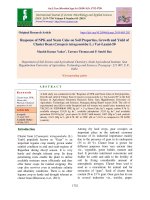
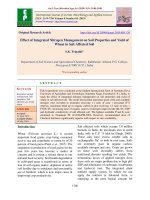
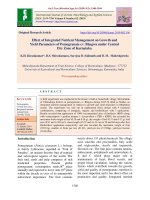
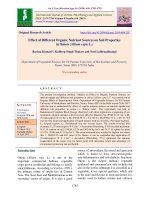

![Correlation studies in the induced mutant population of cluster bean [Cyamopsis tetragonoloba (l.) Taub.]](https://media.store123doc.com/images/document/2020_01/14/medium_tkq1578948472.jpg)
